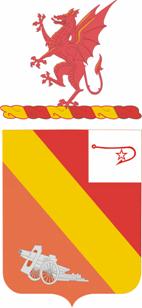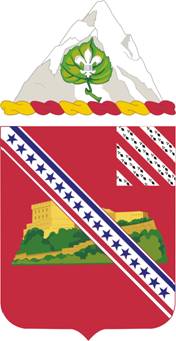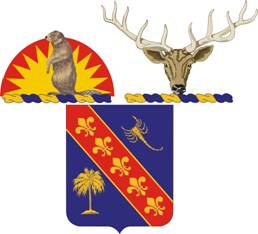
The 3rd Battalion, 16th Field Artillery Regiment is a field artillery battalion assigned to the 2nd Brigade Combat Team, 4th Infantry Division. Carrying the lineage of Battery C, 16th Field Artillery Regiment, the battalion carries campaign streamers from World War I, World War II, and Vietnam, and has served with the 4th Infantry Division and 8th Infantry Division. The unit's nickname is "Rolling Thunder", and their motto is "Macte Nova Virtute". The battalion is composed of a headquarters and headquarters battery (HHB), three cannon batteries, and has an attached Forward Support Company, Company F, 15th Brigade Support Battalion.

The 12th Field Artillery Regiment is a unit of the United States Army.

The 7th Air Defense Artillery Regiment is an air defense artillery regiment of the United States Army, first constituted in the Regular Army as the 7th Regiment of Artillery on 8 March 1898. The 6th and 7th U.S. Artillery Regiments were constituted on 8 March 1898, three weeks after the explosion of USS Maine in Havana, Cuba on 15 February 1898, as the United States' declaration of war on Spain and commencement of the Spanish–American War seemed imminent.

The 6th Field Artillery Regiment is a Field Artillery Branch regiment of the United States Army first activated in 1907 from numbered companies of artillery. It was first organized with two battalions.
The 8th Field Artillery Regiment is a field artillery regiment of the United States Army first formed in 1916. The regiment served in World War I, World War II, and Korea, and regimental units have served in Vietnam, Honduras, Panama, Operation Desert Storm, Operation Enduring Freedom and Operation Iraqi Freedom. Currently organized as a parent regiment under the U.S. Army Regimental System, the regiment's only active component is the 2nd Battalion, 8th Field Artillery Regiment, currently assigned to the 1st Infantry Brigade Combat Team, 11th Airborne Division and stationed at Fort Wainwright, Alaska.

The 13th Field Artillery Regiment is a field artillery regiment of the United States Army first formed in 1916.
The 16th Field Artillery Regiment is a field artillery regiment of the United States Army. The regiment served with the 4th Division in World War II and with the 4th and 8th Divisions between the World Wars. As the 16th Armored Field Artillery Battalion, it served with the 9th Armored Division during World War II, and with the 2nd Armored Division after the war. Designated a parent regiment under the Combat Arms Regimental system, and later the U.S. Army Regimental System, since 1957, regimental elements have served with the 1st, 2nd and 4th Armored Divisions; the 4th, 8th, and 81st Infantry Divisions; and the 1st Cavalry Division. Regimental elements have participated in combat in Vietnam, and in Operation Iraqi Freedom. The regiment currently has a single active battalion, the 3rd Battalion, 16th Field Artillery, assigned to the 2nd Brigade Combat Team, 1st Cavalry Division and stationed at Fort Cavazos, Texas.

The 17th Field Artillery Regiment is a field artillery regiment of the United States Army first formed in 1916.

The 25th Field Artillery Regiment is a field artillery regiment of the United States Army, first constituted 5 July 1918 in the National Army (USA). Although the regiment did not see action during World War I, elements participated in World War II, Vietnam, Panama, the Gulf War, and the Global War on Terrorism. Currently the regiment one active battalion, a towed light artillery units equipped with the M119A3 105 mm howitzer and the M777A2 155 mm howitzer. The 5th Battalion is assigned to the 3rd Brigade Combat Team, 10th Mountain Division at Fort Johnson, Louisiana. The 4th Battalion was inactivated on 14 August 2014.

The 26th Field Artillery Regiment is a field artillery regiment of the United States Army first constituted 5 July 1918 in the National Army (USA).

The 77th Field Artillery Regiment is a field artillery regiment of the United States Army. First constituted 1916 in the Regular Army as a cavalry regiment. Reorganized in 1917 as field artillery and given its current designation.
The 79th Field Artillery Regiment is a field artillery regiment of the United States Army. First constituted 1916 in the Regular Army.

The 43rd Air Defense Artillery Regiment is an air defense artillery regiment of the United States Army first constituted 1918 in the Regular Army.
The 377th Field Artillery Regiment is a field artillery regiment of the United States Army. A parent regiment under the U.S. Army Regimental System, the regiment's 2nd Battalion, 377th Field Artillery Regiment is assigned to the 2nd Infantry Brigade Combat Team (Airborne), 11th Airborne Division. Elements of the regiment have also served with the 101st Airborne Division and 82nd Airborne Division, and have seen service in World War II, Vietnam, and in both Iraq and Afghanistan during the Global War on Terror. The 1st and 3rd Battalions as well as Batteries D and E are Inactive.

The 148th Field Artillery Regiment is a Field Artillery Branch regiment of the Army National Guard.

The 2nd Infantry Division Artillery (DIVARTY) or "Warrior Strike" is the Force Field Artillery Headquarters for the 2nd Infantry Division. The DIVARTY served with the division from 1917 to present, including combat service in World War I, World War II, and the Korean War. In addition to peacetime service with the division at Fort Lewis, Washington, Fort Benning, Georgia, and in Japan and Alaska, the DIVARTY spent 40 years in Korea. After seven years stationed at Joint Base Lewis–McChord, where the DIVARTY provided fire support coordination and mission command for the training and readiness of five field artillery battalions, the Army restationed the DIVARTY to Camp Humphreys on 16 September 2021.
The 1st Cavalry Division Artillery (DIVARTY) or "Red Team" is the Force Field Artillery Headquarters for the 1st Cavalry Division. The DIVARTY served with the division from 1941 to 2005, including combat service in World War II, the Korean War, the Vietnam War, Operations Desert Shield and Desert Storm, and Operation Iraqi Freedom and in peacetime in Japan, Korea, and Fort Cavazos, Texas. As the Force Fires Headquarters, the DIVARTY provides fire support coordination and mission command for the training and readiness of field artillery units across the division.

The 101st Airborne Division Artillery (DIVARTY) is the force fires headquarters for the 101st Airborne Division at Fort Campbell, Kentucky. The DIVARTY has served with the division in World War II, Vietnam, Operations Desert Shield and Storm, Operation Iraqi Freedom, and in peacetime at Camp Breckinridge and Fort Campbell, Kentucky, and Fort Jackson, South Carolina. The DIVARTY was inactivated in 2005 as part of transformation to modular brigade combat teams, but was reactivated on 16 October 2014 to provide fire support coordination and mission command for the training and readiness of field artillery units across the division.

The 2nd Battalion, 320th Field Artillery Regiment is an inactive field artillery battalion of the United States Army. The battalion has been assigned to the 82nd Airborne Division, 11th Airborne Division and 101st Airborne Division. The battalion has participated in World War I, World War II, Vietnam, Operation Desert Storm, Operation Iraqi Freedom, and Operation Enduring Freedom. The battalion deactivated in July 2015 as part of ongoing force reductions, and its personnel and equipment were reflagged as the 2nd Battalion, 32nd Field Artillery Regiment.
















